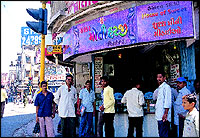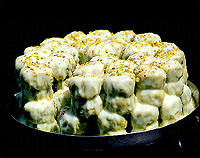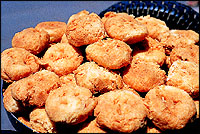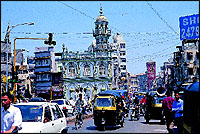IT is amazing, none of the wonderful Indian cookery books on Gujarati and especially Surti cuisine, describe the making process of Ghari ´┐¢ the ghee-rich, laddoo-like mava sweet that is so famous in all of Surat. In fact, some of the most renowned cookery books written by great Indian cooks and culinary experts do not even acknowledge Ghari in their sections on Sweetmeats. Just as well, then, that there is the Thakar Moti Harji Mithaiwala in Surat, the world-famous Ghari-maker.
 This mithaiwala is located in the Bhagal area, another small shop on a kerb, with a mosque in the front and a busy junction all around on which traffic buzzes 24 hours a day. However, the shop is not open around the clock. Except on Chandipadva day around Diwali when the shopkeeper makes a fortune just selling tonnes of Ghari. The shopkeeper is Mukesh Parshottam Thakar. His great-grandfather Moti Harji started the mithai shop in 1830. And it has been at this junction ever since. ´┐¢My brother and I have modernised it a bit, otherwise everything in the shop remains the same,´┐¢ Mukesh said.
This mithaiwala is located in the Bhagal area, another small shop on a kerb, with a mosque in the front and a busy junction all around on which traffic buzzes 24 hours a day. However, the shop is not open around the clock. Except on Chandipadva day around Diwali when the shopkeeper makes a fortune just selling tonnes of Ghari. The shopkeeper is Mukesh Parshottam Thakar. His great-grandfather Moti Harji started the mithai shop in 1830. And it has been at this junction ever since. ´┐¢My brother and I have modernised it a bit, otherwise everything in the shop remains the same,´┐¢ Mukesh said.
 Thakar Moti Harji Mithaiwala has been famous for its Ghari right from the start. ´┐¢Every halwai makes it in Surat, but we have a monopoly in Ghari, and our Pista, Mawa and Badam-Kesar-Pista variety of the mithai is also very popular,´┐¢ said Mukesh. The Ghari can be kept for a week without refrigeration, it is so rich in ghee. Surti NRIs buy kilos of it when they come for their annual vacation and take it back with them. They refrigerate the Ghari and enjoy it for upto three months thereafter. Mukesh has customers in London, and several cities of the US and Canada.
Thakar Moti Harji Mithaiwala has been famous for its Ghari right from the start. ´┐¢Every halwai makes it in Surat, but we have a monopoly in Ghari, and our Pista, Mawa and Badam-Kesar-Pista variety of the mithai is also very popular,´┐¢ said Mukesh. The Ghari can be kept for a week without refrigeration, it is so rich in ghee. Surti NRIs buy kilos of it when they come for their annual vacation and take it back with them. They refrigerate the Ghari and enjoy it for upto three months thereafter. Mukesh has customers in London, and several cities of the US and Canada.
 The Ghari takes five hours to make. Mukesh explains the process simply: Mava is boiled and boiled and then cooled and rolled in the palm to make a kind of laddoo. This mava laddoo is then rolled out like a roti. And it is fried in pure desi ghee. It is folded, then cooled again, and layered with ghee all over again. The sweet is then garnished with chopped badam and pista. When it is cut open, or bitten into, the ghee melts in the mouth and mixes with the flavours of the Ghari. It tastes awesome!
The Ghari takes five hours to make. Mukesh explains the process simply: Mava is boiled and boiled and then cooled and rolled in the palm to make a kind of laddoo. This mava laddoo is then rolled out like a roti. And it is fried in pure desi ghee. It is folded, then cooled again, and layered with ghee all over again. The sweet is then garnished with chopped badam and pista. When it is cut open, or bitten into, the ghee melts in the mouth and mixes with the flavours of the Ghari. It tastes awesome!
 The Ghari apart, Thakar Moti Harji Mithaiwala is also famous for its Doodhi and Chickoo Halwa, both made naturally, and without any artificial flavourings and colours. What goes into it then? The doodhi and chickoo, and mava, sugar, cardamom, ghee. Both cost Rs. 140 a kilo. The Ghari is more expensive. It costs Rs. 160 a kilo for the Mava one, Rs. 200 for the Pista variety and Rs. 240 for the Badam-Kesar-Pista. This is money well spent. For the Ghari is VFM. Ask any Surti NRIs you know who take it abroad with them and see!
The Ghari apart, Thakar Moti Harji Mithaiwala is also famous for its Doodhi and Chickoo Halwa, both made naturally, and without any artificial flavourings and colours. What goes into it then? The doodhi and chickoo, and mava, sugar, cardamom, ghee. Both cost Rs. 140 a kilo. The Ghari is more expensive. It costs Rs. 160 a kilo for the Mava one, Rs. 200 for the Pista variety and Rs. 240 for the Badam-Kesar-Pista. This is money well spent. For the Ghari is VFM. Ask any Surti NRIs you know who take it abroad with them and see!





 Ghari! King Of Sweetmeats
Ghari! King Of Sweetmeats
 This mithaiwala is located in the Bhagal area, another small shop on a kerb, with a mosque in the front and a busy junction all around on which traffic buzzes 24 hours a day. However, the shop is not open around the clock. Except on Chandipadva day around Diwali when the shopkeeper makes a fortune just selling tonnes of Ghari. The shopkeeper is Mukesh Parshottam Thakar. His great-grandfather Moti Harji started the mithai shop in 1830. And it has been at this junction ever since. ´┐¢My brother and I have modernised it a bit, otherwise everything in the shop remains the same,´┐¢ Mukesh said.
This mithaiwala is located in the Bhagal area, another small shop on a kerb, with a mosque in the front and a busy junction all around on which traffic buzzes 24 hours a day. However, the shop is not open around the clock. Except on Chandipadva day around Diwali when the shopkeeper makes a fortune just selling tonnes of Ghari. The shopkeeper is Mukesh Parshottam Thakar. His great-grandfather Moti Harji started the mithai shop in 1830. And it has been at this junction ever since. ´┐¢My brother and I have modernised it a bit, otherwise everything in the shop remains the same,´┐¢ Mukesh said. Thakar Moti Harji Mithaiwala has been famous for its Ghari right from the start. ´┐¢Every halwai makes it in Surat, but we have a monopoly in Ghari, and our Pista, Mawa and Badam-Kesar-Pista variety of the mithai is also very popular,´┐¢ said Mukesh. The Ghari can be kept for a week without refrigeration, it is so rich in ghee. Surti NRIs buy kilos of it when they come for their annual vacation and take it back with them. They refrigerate the Ghari and enjoy it for upto three months thereafter. Mukesh has customers in London, and several cities of the US and Canada.
Thakar Moti Harji Mithaiwala has been famous for its Ghari right from the start. ´┐¢Every halwai makes it in Surat, but we have a monopoly in Ghari, and our Pista, Mawa and Badam-Kesar-Pista variety of the mithai is also very popular,´┐¢ said Mukesh. The Ghari can be kept for a week without refrigeration, it is so rich in ghee. Surti NRIs buy kilos of it when they come for their annual vacation and take it back with them. They refrigerate the Ghari and enjoy it for upto three months thereafter. Mukesh has customers in London, and several cities of the US and Canada. The Ghari takes five hours to make. Mukesh explains the process simply: Mava is boiled and boiled and then cooled and rolled in the palm to make a kind of laddoo. This mava laddoo is then rolled out like a roti. And it is fried in pure desi ghee. It is folded, then cooled again, and layered with ghee all over again. The sweet is then garnished with chopped badam and pista. When it is cut open, or bitten into, the ghee melts in the mouth and mixes with the flavours of the Ghari. It tastes awesome!
The Ghari takes five hours to make. Mukesh explains the process simply: Mava is boiled and boiled and then cooled and rolled in the palm to make a kind of laddoo. This mava laddoo is then rolled out like a roti. And it is fried in pure desi ghee. It is folded, then cooled again, and layered with ghee all over again. The sweet is then garnished with chopped badam and pista. When it is cut open, or bitten into, the ghee melts in the mouth and mixes with the flavours of the Ghari. It tastes awesome! The Ghari apart, Thakar Moti Harji Mithaiwala is also famous for its Doodhi and Chickoo Halwa, both made naturally, and without any artificial flavourings and colours. What goes into it then? The doodhi and chickoo, and mava, sugar, cardamom, ghee. Both cost Rs. 140 a kilo. The Ghari is more expensive. It costs Rs. 160 a kilo for the Mava one, Rs. 200 for the Pista variety and Rs. 240 for the Badam-Kesar-Pista. This is money well spent. For the Ghari is VFM. Ask any Surti NRIs you know who take it abroad with them and see!
The Ghari apart, Thakar Moti Harji Mithaiwala is also famous for its Doodhi and Chickoo Halwa, both made naturally, and without any artificial flavourings and colours. What goes into it then? The doodhi and chickoo, and mava, sugar, cardamom, ghee. Both cost Rs. 140 a kilo. The Ghari is more expensive. It costs Rs. 160 a kilo for the Mava one, Rs. 200 for the Pista variety and Rs. 240 for the Badam-Kesar-Pista. This is money well spent. For the Ghari is VFM. Ask any Surti NRIs you know who take it abroad with them and see!